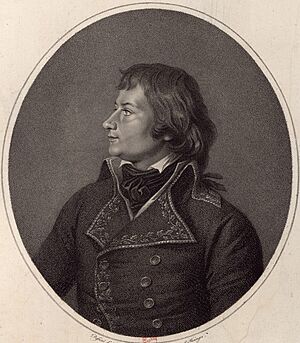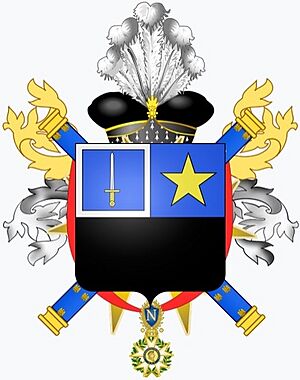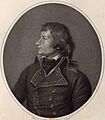Laurent de Gouvion Saint-Cyr facts for kids
Quick facts for kids
Marshal of the Empire
Laurent de Gouvion Saint-Cyr
Marquis of Gouvion-Saint-Cyr
|
|
|---|---|

Portrait by Horace Vernet, 1821
|
|
| Minister of War | |
| In office 7 July 1815 – 26 September 1815 |
|
| Preceded by | Louis-Nicolas Davout |
| Succeeded by | Henri Jacques Guillaume Clarke |
| In office 12 September 1817 – 19 November 1819 |
|
| Preceded by | Henri Jacques Guillaume Clarke |
| Succeeded by | Victor de Fay de La Tour-Maubourg |
| Minister of the Navy and the Colonies | |
| In office 23 June 1817 – 12 September 1817 |
|
| Preceded by | François Joseph de Gratet, Vicomte de Dubouchage |
| Succeeded by | Louis-Mathieu Molé |
| Personal details | |
| Born | 13 April 1764 Toul, Three Bishoprics, Kingdom of France |
| Died | 17 March 1830 (aged 65) Hyères, Var, Kingdom of France |
| Awards | Grand Cross of the Legion of Honour |
| Military service | |
| Allegiance | |
| Branch/service | French Royal Army French Revolutionary Army French Imperial Army French Royal Army |
| Years of service | 1792–1814 1815–1819 |
| Rank | Marshal of the Empire |
| Battles/wars |
See list:
|
Laurent de Gouvion Saint-Cyr (born April 13, 1764 – died March 17, 1830) was a French military leader. He fought in the French Revolutionary Wars and the Napoleonic Wars. He rose to become a Marshal of the Empire, which was a very high military rank. Many people believed he was Napoleon's best commander when it came to defending positions. He was also known as the 1st Marquis of Gouvion-Saint-Cyr.
Contents
Early Life and Beginnings
Laurent Gouvion was born in Toul, France. His father, Jean-Baptiste Gouvion, was a tanner. Laurent later added "Saint-Cyr" to his name, which was his mother's name.
When he was 18, he went to Rome to study painting. He continued his art studies in Paris in 1784. However, he never became a professional painter. He married Anne Gouvion and they had children together.
Military Career During the Revolution
In 1792, Saint-Cyr joined the army as a captain in a volunteer group. He quickly moved up the ranks. Within two years, he became a general.
- In 1796, he led a key part of General Jean Victor Marie Moreau's army during a famous retreat from Bavaria to the Rhine River.
- In 1798, he took command of the French army in Italy.
- The next year, he fought in Germany and then joined Moreau's army in Italy. He showed great skill after the French defeat at the Battle of Novi.
- Some generals, like Moreau, found him difficult to work with. However, other generals, such as Michel Ney and Louis-Nicolas Davout, often thanked him for his support in battles.
- In 1800, he helped Moreau win a victory at Biberach.
- In 1801, Saint-Cyr was sent to Spain to lead an army planning to invade Portugal. He was later made an ambassador in Madrid.
Serving Under Napoleon
Saint-Cyr was a very principled person. He refused to sign a paper celebrating the start of the French Empire. Because of this, his name was not on the first list of Napoleon's Marshals. He believed Napoleon purposely held him back.
- In 1803, he commanded an army group in Italy.
- He fought well under Marshal André Masséna in 1805.
- In 1806, he was part of the French invasion of Naples.
- In 1808, he became a count and led an army group in Catalonia, Spain. However, he disagreed with some orders and resigned. He remained out of favor until 1811.
Becoming a Marshal
Even though he was a skilled general, he wasn't made a Marshal until later. In 1812, during Napoleon's invasion of Russia, Saint-Cyr commanded the VI Corps.
- On August 18, 1812, he won a victory against the Russians at First Battle of Polotsk. For this important win, Napoleon finally made him a Marshal.
- He was wounded during the French retreat from Russia.
- In 1813, Saint-Cyr fought bravely at the Battle of Dresden. He defended the city against the Allies even after Napoleon had retreated. He only surrendered on November 11.
- Napoleon later said that Saint-Cyr was unmatched among his marshals and was as good as Napoleon himself in defense.
Later Life and Reforms
After Napoleon's rule ended, the French monarchy was restored.
- In 1815, Saint-Cyr became a Peer of France and was appointed Minister of War. He resigned a few months later.
- He tried to help his friend, Marshal Michel Ney, who was facing trial.
- In 1817, he became the Minister of the Navy and then again the Minister of War. He held this position until 1819.
- During this time, he made many important changes to the French army. He worked to make the army more national and less tied to the royal family.
- He also protected the rights of veteran soldiers, organized the army's staff, and updated military laws and pension rules.
- He was made a marquess in 1817.
- Laurent de Gouvion Saint-Cyr died on March 17, 1830, in Hyères, France.
In Books
Marshal Saint-Cyr is mentioned in a short story called "The Duel" by Joseph Conrad. This story was also made into a movie called The Duellists. He is also mentioned in the book "The Red and the Black" by Stendhal.
His Writings
Saint-Cyr wrote several books about his military experiences:
- Journal des opérations de l'armée de Catalogne en 1808 et 1809 (1821) - This book is about the army's actions in Catalonia.
- Mémoires sur les campagnes des armées de Rhin et de Rhin-et-Moselle de 1794 à 1797 (1829) - These are his memories of campaigns in the Rhine region.
- Mémoires pour servir de l'histoire militaire sous le Directoire, le Consulat et l'Empire (1831) - This book covers military history during the Directory, Consulate, and Empire periods.
Images for kids
See also
 In Spanish: Laurent de Gouvion-Saint-Cyr para niños
In Spanish: Laurent de Gouvion-Saint-Cyr para niños






